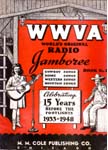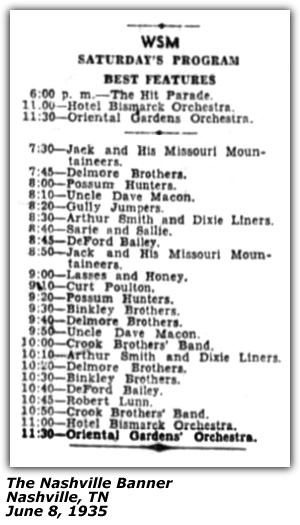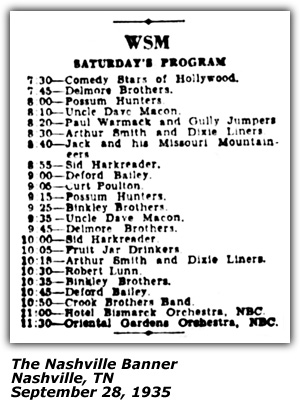



|
 |
|||||||||||||||
|
About The Artist In the summer of 1935, WSM seemed to forgo the traditional music heard on the Grand Ole Opry on Saturday nights. Radio logs published indicate the Opry program was on WSM from 8:00pm to 12:00pm (midnight). Once again the last hour of the Opry portion was devoted to network dance band programs. One such act was Roy Maxon and the Oriental Gardens Orchestra of Chicago, Illinois. The band had a half-hour slot at 11:30pm each Saturday night from June 8, 1935 to September 28, 1935.
When he got out of school, he immediately took a position working on the railroads starting out as an 'oil boy' then gradually got himself put into the position of fireman. But even while doing such work, he had an interest in music — he studied in his spare time. It was during a railroad strike that he decided to turn his career to music professionally. His debut was in an East St. Louis cafe. Then he began his itinerant career, taking a position on the showboat, "Sunny South." He played the 'steam caliope' before the shows, the piano during interludes and then doubled as a blood hound in the show, "Uncle Tom's Cabin." He left the showboat and headed to New Orleans and found work as a pianist. He took a position with George Olsen's band, then, a group of five men. But he left Olsen's band within a week. Roy was quoted, "He soon found out that the chords I played with my left hand did not coincide with the banjo. The banjoist was reading the music and I wasn't." He found work playing the trombone and baritone in the Clefton-Kelly carnival, a tent show operation that was playing in Louisiana and Mississippi. He found work as a trombonist with a new Dixieland Band. The group played in New York for six weeks. But service to his country called; he enlisted as a private in the U. S. Army and in two and a half months, was commissioned as second lieutenant. Roy's sergeant was orchestra leader Jack Denny. The two of them took on the task of creating a battalion band. They started at 9 in the morning one day and by 4pm that afternoon, they were practicing a 17-piece band. Upon his commission, he was assigned bandmaster and received orders to go to France. He was on the Empress of Britain, seemingly enjoying the trip until they encountered a German submarine that torpedoed the ship. The boat was in the Irish sea at the time and were able to limp into Liverpool under its own steam power. By a twist of fate, Maxon's battalion was sent to Winchester, England to help build a railroad. They were supposed to be in France with the rest of the regiment that was practically wiped out. But there was an interesting tidbit in the story about the visit to the Winchester Cathedral with his band. "The archbishop, who had never heard an American (black) band play, expressed a desire to have the orchestra play "Rock of Ages." " Roy heard the request and took a trumpet and sounded the "assembly call." The following day, someone told Roy was the first man to blow a brass instrument in the cathedral "...since Cromwell desecrated it." But the archbishop did not consider it any harm. In fact, he gave Roy a baton of wood that had been carved from a log under the crypt. The log itself was laid in the foundation of the cathedral in the year of 1202. When World War I had ended, Roy actually had the only American band in England. Thus, he got an invitation to play at the victory ball in London. Later, he played before King George and the Prince of Wales. When he returned home to St. Louis, he felt that there was nothing for him to do. He took a trip to Chicago and joined a band that was forming. It was the Oriole Terrace Orchestra that was directed by Dan Russo and Ted Fio-Rito. Roy then went on to play for Arnold Johnson and then to Paul Whiteman's band. He stayed with Whiteman over four years when he hooked up with Paul Ash's band. Following that gig, he played in an 'all-star unit' that ws directed by Isham Jones. In early 1934, he had been playing for the Balaban and Katz theaters before he began to rehearse his own orchestra for a night spot in Chicago. But that deal fell through and he was offered the Schroeder Hotel job.
 
Roy moved to the Miami, Florida area around 1937 or so from New York. His obituary indicated he was a member of both the Miami and New York Federations of Musicians. He died in Augusta, Georgia on Saturday, June 21, 1952. He was buried in Graceland Memorial Park in Coral Gables, FL. He was survived by his wife, Bernice and a son, Captain Leroy J. Maxon.
Credits & Sources
|
| Printer Friendly Version |
Hillbilly-Music.com
Yes, Hillbilly Music. You may perhaps wonder why. You may even snicker. But trust us, soon your feet will start tappin' and before you know it, you'll be comin' back for more...Hillbilly Music.
Hillbilly-music.com ...
It's about the people, the music, the history.
|
Copyright © 2000—2023 Hillbilly-Music.com
|
||||